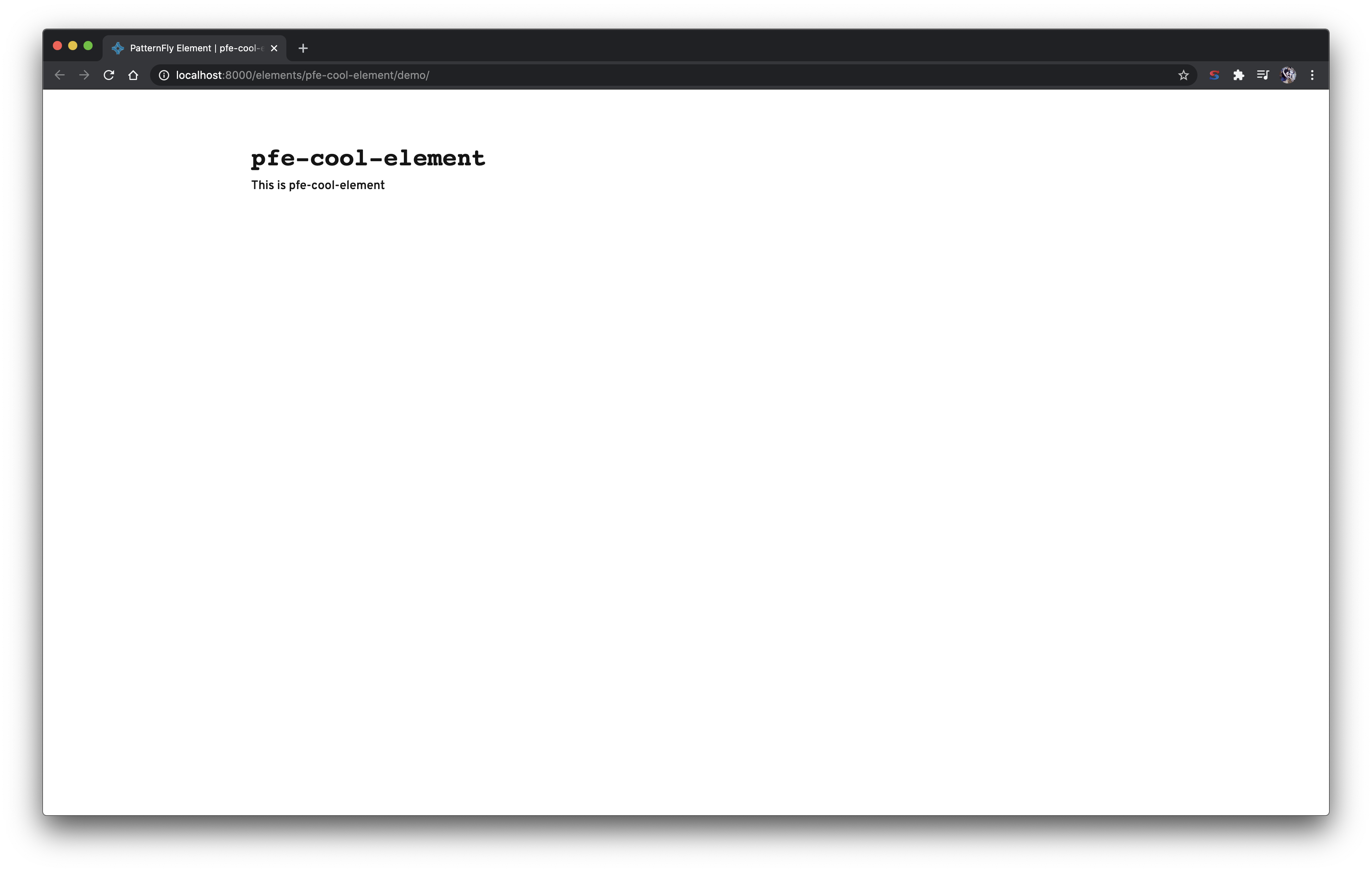Develop a structure
Run this command from the project root to start the build, watch, and server processes, see others in the project README.
npm run devThe server will load on http://localhost:8000 by default.

Assuming the dev command started a server on port 8000, navigate to http://localhost:8000/demo/pfe-cool-element/ to view your element.
You're off to a good start! You have a new custom element that extends the base LitElement class.
Let's take a look at the pfe-cool-element.ts file to see what we have.
import { LitElement, html } from 'lit';
import { customElement } from 'lit/decorators.js';
import { pfelement } from '@patternfly/pfe-core/decorators.js';
import styles from './pfe-cool-element.scss';
/**
* Cool Element
* @slot - Place element content here
*/
@customElement('pfe-cool-element') @pfelement()
export class PfeCoolElement extends LitElement {
static readonly version = '';
static readonly styles = [styles];
render() {
return html`
<slot></slot>
`;
}
}
declare global {
interface HTMLElementTagNameMap {
'pfe-cool-element': PfeCoolElement;
}
}Lit
import { LitElement, html } from 'lit';First, notice that our element extends from LitElement instead of HTMLElement. Lit provides a few key features on top of standard web components (i.e. HTMLElement):
- Observed Properties. Any time an observed property changes, the component automatically and performantly updates based on the new state.
- Declarative Templates. The
htmltemplate literal tag function lets you define HTML elements and attributes as well as JavaScript DOM properties and event listeners in a simple, familiar syntax.
Unlike PFE 1.0's PFElement base class, Lit template updates (i.e. renders) are asynchronous. What this means for developers is that once they set an observed property, they should await element.updateComplete to ensure that changes to the DOM are applied if they need to do any work based on the results.
For example, with PFElement we could handle the side-effects of our actions immediately:
const element = document.querySelector('pfe-tabs');
// Select the 2nd Tab
element.selectIndex(1);
// Side effects happen immediately,
// so let's get a reference to the newly-active tab
const active = element.querySelector('[aria-selected="true"]');
// Do something with the newly-active tabWith LitElement, we must wait for our changes to apply before continuing:
const element = document.querySelector('pfe-tabs');
// Select the 2nd Tab
element.selectIndex(1);
- // Side effects happen immediately,
- // so let's get a reference to the newly-active tab
+ // Wait for changes to take effect
+ // and only then get a reference to the newly-active tab
+ await element.updateComplete;
const active = element.querySelector('[aria-selected="true"]');
// Do something with the newly-active tabThese changes usually take mere milliseconds to occur, so this doesn't affect end-users, but developers should be aware.
Read more about Lit on their site.
TypeScript Decorators
Second, we define HTML tag name using lit's @customElement() TypeScript decorator.
Decorators are a proposed JavaScript language feature.
TypeScript implements an experimental version of the decorator language feature with a slightly different internal API.
@customElement('pfe-cool-element') @pfelement()We also apply the @pfelement() decorator from @patternfly/pfe-core, which provides some common features for all PatternFly Elements,
like colour-context awarerness, and optional performance tracking.
Third, we import an use our component's SASS styles
import styles from './pfe-cool-element.scss';static readonly styles = [styles];Of course, web browsers don't know how to import .scss files as CSS styles. In the near future, we will use
import assertions to import CSS modules,
but for now, we use some build-time tricks to transform our SASS sources into JavaScript objects which work with LitElement.
For questions on how Custom Elements work, or if you want to learn the basics of shadow DOM, check out Eric Bidelman's post: Custom Elements v1: Reusable Web Components.
Now that our dev server is running and we have our element's structure, let's make it actually do something.